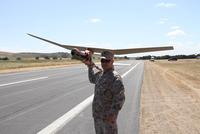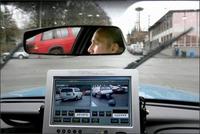-
U.S. military seeking non-lethal UAVs

The U.S. Army is seeking non-lethal warheads to be deployed on tiny UAVs; the U.S. Army describes the possible uses of the non-lethal UAV: “Potential commercial applications might include, but are not limited to: crowd control for local law enforcement; border protection for Homeland Security; or temporary incapacitation of non violent criminals for local SWAT teams and/or law enforcement”
-
-
First U.S. drone attack in Pakistan in a month kills four terrorists
Yesterday, Sunday, missiles launched from a CIA drone missiles hit military targets in Pakistan for the first time in a month. The attack killed four al Qaeda members, but further heightening tensions between the United States and Pakistan. Back in November 2011, U.S. airstrikes, called in by Pakistani commanders n the ground, killed twenty-four Pakistani soldiers. In response, Pakistan said that unless the United States apologized for the incident, no more U.S. drone attack would be allowed against terror targets inside Pakistan. The United States expressed regrets over the death of the soldiers, but refused to apologize, saying the accident was the result of mistakes and miscommunication on both sides. Since November, the United States has reduced considerably the number of drone attacks inside Pakistan, but has refused to end such attacks altogether. The U.S. refusal has led to Pakistani parliament, on three different occasions, to pass resolutions calling upon the United States to cease and desist.
-
-
New micro helicopters for search and rescue missions
New micro helicopters have a diameter of about fifty centimeters, weigh only 1,500 grams; they do not rquire GPS or remote control to navigate; they are designed to maneuver in tight or even enclosed spaces, and to detect and fly around any obstacle; possible uses could include protection or rescue missions, and they are ideal for flying over disaster areas and giving a picture of the situation from the air or locating victims
-
-
Cellphones could soon see through walls
Researchers have designed an imager chip that could turn mobile phones into devices that can see through walls, wood, plastics, paper, and other objects; the chip exploits the terahertz band of the electromagnetic spectrum, which is one of the wavelength ranges that falls between microwave and infrared, and which has not been accessible for most consumer devices
-
-
Worldwide UAV market to reach more than $94 billion in ten years
UAV spending will almost double over the next decade from current worldwide UAV expenditures of $5.9 billion annually to $11.3 billion, totaling just over $94 billion in the next ten years; the UAV payload market, worth $2.6 billion in Fiscal Year 2011, is forecast to increase to $5.6 billion in Fiscal Year 2020
-
-
Security industry helps develop DOJ/DHS Suspicious Activity training video
The National Association of Security Companies says it endorses the DOJ/DHS Suspicious Activity Reporting (SAR) training video for private sector security personnel
-
-
India's demand for CCTVs growing fast
Since the Mumbai terrorist attacks in 2008, city surveillance has become a high priority for India; India has twenty-eight states, most with a capital city and a number of other large cities, and video surveillance is being planned for many of them
-
-
DHS brings military technology to border surveillance
The long list of products and equipment developed for the military but which were adapted to and adopted by civilian and law enforcement agencies has a new entry. Add to the list the Kestrel: a L-3 Wescam MX 360-degree camera mounted to a Raven Aerostar aerostat
-
-
New surveillance system: 1 second to search through 36 million faces
New surveillance camera system can search through data on thirty-six million faces in one second
-
-
DHS resisted calls for intelligence on Occupy movement
Internal documents released by DHS demonstrate the efforts made by the department to avoid gathering intelligence on last year’s Occupy movement
-
-
California bill would restrict data usage from license plate scanners

Legislation has been introduced in California to limit the use of data gathered by patrol car-mounted license plate readers, and the duration for which such data may be held; access to the data by other agencies and personnel would be limited as well
-
-
Small UAV wins Border Security Product Challenge award
A small surveillance UAV catches the eye of law enforcement and the military; it is an electric-powered, lightweight, portable system that fits in a small rucksack. Its modular design enables assembly and launch in less than two minutes
-
-
Surveillance technology along the border
A South Dakota blimp maker has one of its airships take part in a border security technology demonstration; the demonstration was put together to allow the CBP to evaluate a new surveillance system for use on the border
-
-
Bolstering police anti-child porn technology
Microsoft Corp. and NetClean the other day announced a joint effort to combat the sexual exploitation of children by making Microsoft PhotoDNA technology available and accessible to law enforcement agencies worldwide to help enhance child sex abuse investigations
-
-
Using people with cell phones as surveillance nodes
Eighty-eight percent of Americans now own a cell phone, forming a massive network that offers scientists a wealth of information and an infinite number of new applications; with the help of these phone users — and their devices’ cameras, audio recorders, and other features — researchers envision endless possibilities for gathering huge amounts of data
-
- All
- Regional
- Water
- Biometrics
- Borders/Immig
- Business
- Cybersecurity
- Detection
- Disasters
- Government
- Infrastructure
- International
- Public health
- Public Safety
- Communication interoperabillity
- Emergency services
- Emergency medical services
- Fire
- First response
- IEDs
- Law Enforcement
- Law Enforcement Technology
- Military technology
- Nonlethal weapons
- Nuclear weapons
- Personal protection equipment
- Police
- Notification /alert systems
- Situational awareness
- Weapons systems
- Sci-Tech
- Sector Reports
- Surveillance
- Transportation
Advertising & Marketing: advertise@newswirepubs.com
Editorial: editor@newswirepubs.com
General: info@newswirepubs.com
2010-2011 © News Wire Publications, LLC News Wire Publications, LLC
220 Old Country Road | Suite 200 | Mineola | New York | 11501
Permissions and Policies
Editorial: editor@newswirepubs.com
General: info@newswirepubs.com
2010-2011 © News Wire Publications, LLC News Wire Publications, LLC
220 Old Country Road | Suite 200 | Mineola | New York | 11501
Permissions and Policies
